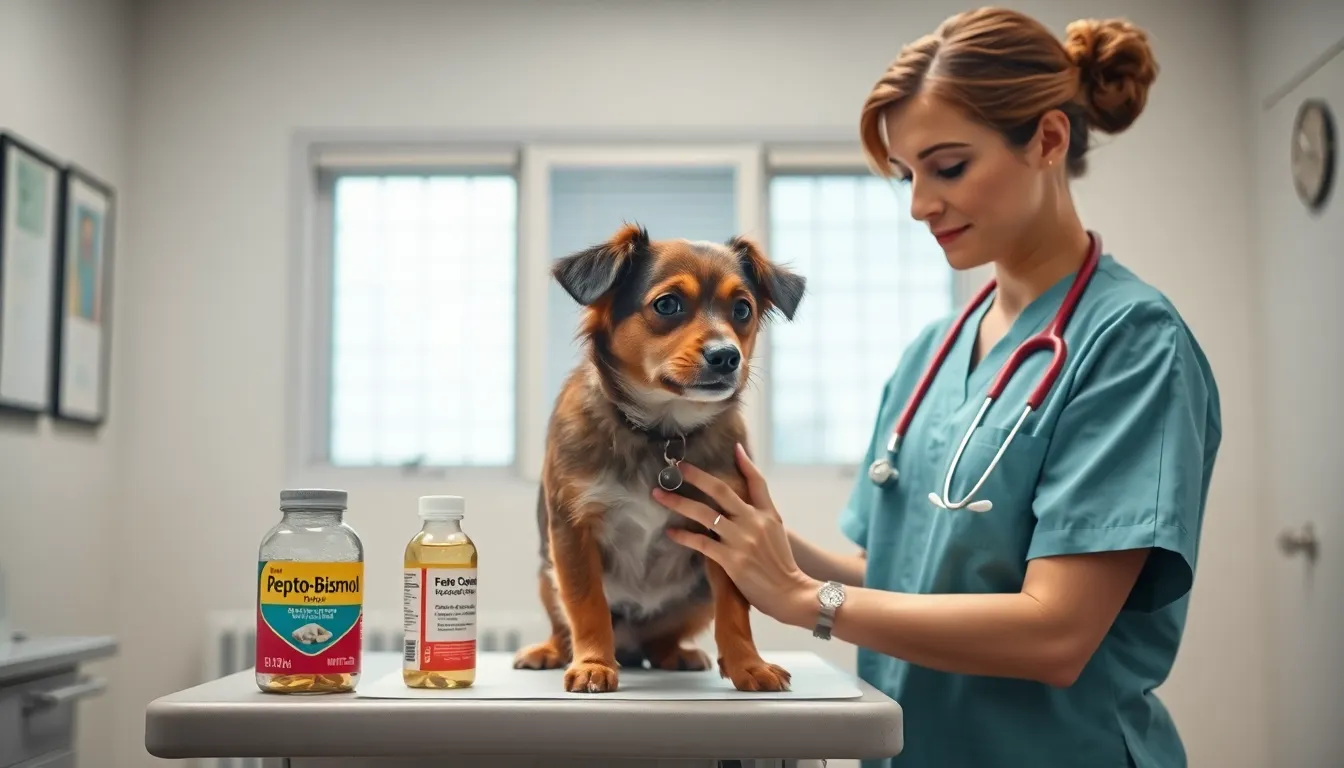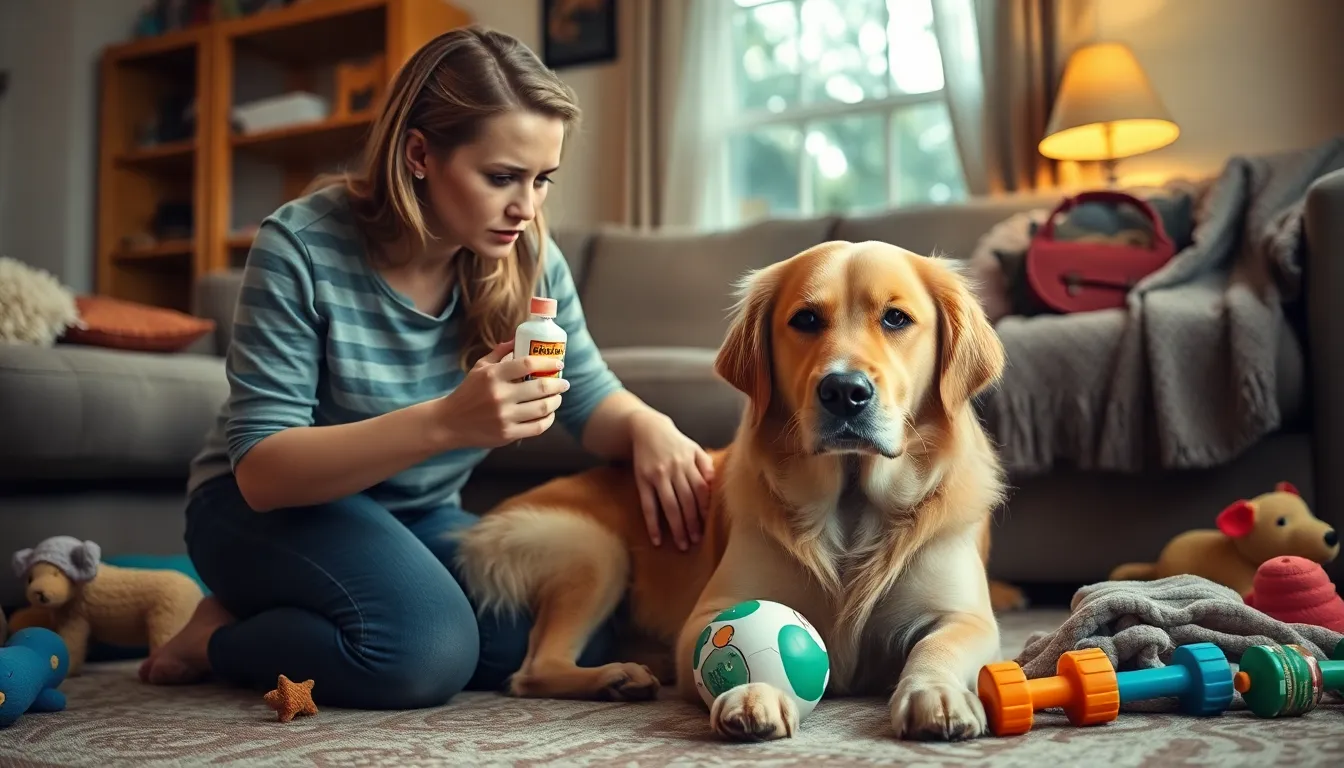When your furry friend’s stomach starts rumbling like a thunderstorm, it’s hard not to panic. Dogs can be notoriously sensitive to what they eat, and that’s where Pepto-Bismol comes in like a superhero in a pink cape. But wait—before you start pouring it into their bowl, you’ve got to know how much is just right. Too little and you might as well be handing them a dog biscuit; too much could turn your pup into a bubblegum machine.
Table of Contents
ToggleUnderstanding Pepto Bismol for Dogs
Pepto-Bismol, known for treating human digestive issues, can also be utilized for dogs under certain circumstances. When a dog experiences gastrointestinal upset, this medication may provide relief.
What Is Pepto Bismol?
Pepto-Bismol, or bismuth subsalicylate, serves as an antidiarrheal and antacid. It works by coating the stomach lining and neutralizing stomach acid. The medication helps alleviate symptoms like nausea, vomiting, and diarrhea in both humans and dogs. It’s crucial to understand that it contains salicylates, which can be harmful in excessive amounts. This medication should not replace veterinary care but may accompany treatment in some cases.
Common Uses in Veterinary Medicine
Veterinarians frequently recommend Pepto-Bismol for dogs suffering from mild cases of diarrhea or upset stomach. It can help soothe an irritated digestive tract. Additionally, it may treat conditions such as gastritis or food sensitivities. Many vets suggest using the liquid form for easier administration and better absorption. It’s essential to consult a vet before giving any medication, including Pepto-Bismol, to ensure safety and efficacy in treatment.
Dosage Guidelines for Dogs

Administering the correct dosage of Pepto-Bismol is crucial for ensuring a dog’s safety and effectiveness of the treatment. Factors such as the dog’s weight, age, and overall health play an essential role in determining the appropriate dosage.
Factors Influencing Dosage
Weight significantly affects how much Pepto-Bismol a dog can tolerate. Younger dogs may react differently than adults due to their developing systems. Medical history also matters; dogs with existing conditions, like liver or kidney issues, require special consideration. The presence of additional medications may complicate dosage recommendations. Always consult a veterinarian, since they can provide personalized advice based on these factors.
Recommended Dosage Based on Weight
Typically, the common dosage for Pepto-Bismol is 0.5 to 1 milligram per pound of a dog’s body weight. For example, a dog weighing 20 pounds might receive around 10 to 20 milligrams. Administer the medication every 6 to 8 hours, but never exceed the maximum daily dosage of 4 doses within 24 hours. Monitoring the dog for any adverse reactions is essential. Adjustments may be necessary, based on how the dog responds to treatment.
Signs of Gastrointestinal Distress in Dogs
Gastrointestinal distress in dogs manifests through various signs. Recognizing these symptoms early can significantly help dog owners determine the best course of action.
Recognizing When to Administer Pepto
Common signs indicating a dog may benefit from Pepto include vomiting, diarrhea, and decreased appetite. Dogs exhibiting nausea often display lethargy or restlessness. Observing these behaviors suggests gastrointestinal upset may be present. Monitoring for other issues, such as bloating or excessive drooling, reinforces the need to consider treatment. If a dog shows these symptoms for more than a day, Pepto may provide relief, but consulting with a veterinarian remains essential.
When Not to Use Pepto Bismol
Certain conditions necessitate avoiding Pepto-Bismol altogether. Dogs experiencing severe vomiting, bloody diarrhea, or signs of dehydration should not receive this medication. Additionally, dogs with known allergies to salicylates cannot tolerate Pepto-Bismol due to potential toxicity. It’s critical to avoid giving this medication if a dog has existing health issues, particularly liver or kidney disease. Consulting a veterinarian is vital when uncertainty arises about administering Pepto or any other medication.
Potential Side Effects and Considerations
Monitoring for side effects is critical when giving Pepto-Bismol to dogs. While this medication can alleviate gastrointestinal distress, it may also cause unwanted reactions.
Common Side Effects in Dogs
Common side effects include constipation, black stools, and mild lethargy. Dogs might experience appetite loss or changes in behavior. If vomiting occurs, or if the dog’s condition worsens, seeking veterinary advice is essential. Less common reactions can involve allergic responses, leading to signs such as swelling, difficulty breathing, or hives. Awareness of these potential effects helps ensure timely intervention.
Interactions with Other Medications
Interactions with other medications can complicate Pepto-Bismol’s safety. It may amplify the effects of anticoagulants, potentially increasing bleeding risks. Concurrent use with corticosteroids or certain anti-inflammatories could also lead to gastrointestinal irritation. Always consult a veterinarian before combining Pepto-Bismol with other treatments. This minimizes the risk of adverse reactions and optimizes therapeutic effectiveness.
Administering Pepto-Bismol to dogs can provide relief for mild gastrointestinal issues when done correctly. It’s essential to follow the recommended dosage guidelines based on the dog’s weight and health status. Monitoring the dog’s reaction to the medication is crucial to ensure safety and effectiveness.
If symptoms persist or worsen it’s important to consult a veterinarian. While Pepto-Bismol can be beneficial for some dogs it shouldn’t replace professional veterinary care. Keeping a close eye on the dog’s overall condition will help in making informed decisions about their health and well-being.



